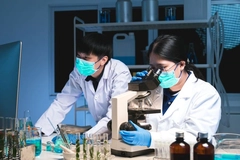Food security threats loom as insects damage crops and hinder local agricultural production
19 Jul 2023 --- The Japanese beetle damaging plants by “skeletoning” leaves might make its way across Washington state, US, in the next 20 years and is posing a threat to the state’s agricultural system, according to a study. Meanwhile, another study stresses the danger of apple snail damage on rice production in Kenya and other African countries, potentially driving malnutrition.
Experts urge that even though the Japanese beetle is challenging to eliminate, it is possible to control.
“These coordinated, intense efforts early in the invasion are critical because if we wait too long, it becomes an endemic problem. Hopefully, we can prevent the beetles from expanding beyond the quarantine areas, at least soon,” says David Crowder, senior author of the US study.

Already spread throughout most of the US starting on the East Coast in 1916, Japanese beetles are now reaching Western territories and were discovered in Washington in 2020, claims the study, published in the Journal of Economic Entomology.
An agricultural threat
The beetles eat more than 300 plant species, such as grapes, hops and cherries – some of Washington’s “favorite” crops posing a “serious threat to agriculture.” The US is the world’s second largest producer of cherries and the Northwest produces 60% of all sweet cherries, according to the Agricultural Marketing Resource Center.
The US Department of Agriculture says it’s also threatening agriculture throughout the US and refers to the beetles as “a highly destructive plant pest of foreign origin.”
 The Japanese beetles are referred to as “a highly destructive plant pest of foreign origin.”Published in Pest Management Science, a separate study stresses that apple snails are posing “serious food security implications” as they threaten the self-sufficient rice production progress Kenya has achieved so far.
The Japanese beetles are referred to as “a highly destructive plant pest of foreign origin.”Published in Pest Management Science, a separate study stresses that apple snails are posing “serious food security implications” as they threaten the self-sufficient rice production progress Kenya has achieved so far.
“The negative impacts will only increase over time as apple snails spread. It is a call for urgent action. There is a rapidly narrowing window of opportunity for potential containment, or possibly even eradication before apple snail becomes widespread in Kenya, and the only feasible option will become management, with its associated high economic, livelihood and environmental costs,” says Fernadis Makale, co-author of the Kenyan study.
Kate Constantine, the lead author of the Kenyan study, stresses that rice farmers in Mwea [nature reserve in Kenya] face various challenges such as water shortages, rice blast attacks, high input costs, low land productivity, machinery shortages, bird damage, poor infrastructure and a lack of resilient and acceptable rice varieties.
“The recent introduction of apple snails has added to these challenges, posing a serious threat to rice production in the region and potentially across Africa,” explains Constantine.
There are currently multiple threats to food security on a global scale as temperatures rise and wildfires spread, damaging crops and overall food production.
Quarantine zones
The US study notes the efficiency of quarantine zones for beetles as they provide guidelines on residential yard waste staying in its designated area and cleaning trucks used for agriculture practices.
Although beetles can fly, “it’s often humans who help them reach new areas,” the researchers say.
“People can notice the adult Japanese beetles very easily, but it’s tough to notice them in the earliest stage of life – the eggs and larvae – so people might unintentionally help with their dispersal,” says Gengping Zhu, WSU research assistant professor and the study’s first author.
“Having an engaged citizenry is important to preventing the spread of invasive species in general, even beyond the Japanese beetle,” says Crowder.
“Problems with invasive species will get worse with climate change and increased human connectivity. The more coordinated we are, and the more we can identify the early stages of these invasions, the better,” concludes Crowder.
By Beatrice Wihlander















